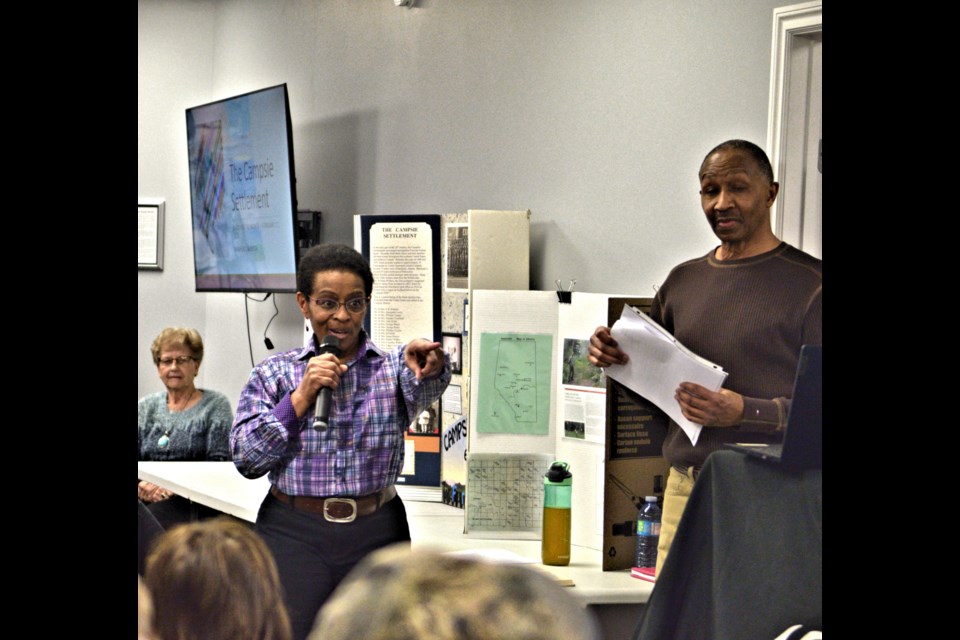BARRHEAD – It seems Paul Beaver did not have to be concerned if anyone would attend his and his sister Christine Beaver's presentation on the history of the black settlement at Campsie in the early 1900s.
That is because it was standing room only as more than 100 people packed the Barrhead and District FCSS building on Thursday, Feb. 16.
The presentation was two-fold, one to commemorate Black History Month and the other to raise money for the Bethel Baptist Cemetery restoration project. Bethel Baptist Cemetery is where many of the original black settlers from Campsie are buried.
Christine and Paul, who now both live in Edmonton but grew up in Tiger Lily, are great-grandchildren (on their father's side) of Hattie and Walker Beaver who settled in Campsie in the spring of 1908. They came from Oklahoma via train crossing into Canada in Manitoba, where they switched trains for Edmonton. After a few months of residing in the Strathcona-Whyte Avenue area, the couple made the trek on foot to Campsie, a journey that took three days.
“The story of Campsie is the story of the descendants of former slaves that came to Canada after Abraham Lincoln abolished slavery in the United States through the emancipation proclamation declaring that every man should be free," Christine said. "But that’s not what happened, of course. People were still working and being enslaved, forbidden to own land, vote and do all those things. So groups of people heard of this place up north where they could go, live their lives in freedom, have a chance to succeed and live the good life, free of oppression.”
So she said that when these former slaves read the newspaper articles and advertisements "about this place up north, where they could go, live their lives in freedom, have a chance to succeed and live the good life, free of oppression,” they seriously considered it.
At the time, the Canadian government worried about potentially losing territory to the U.S., which encouraged immigration to the prairie provinces, and sent advertisements, mostly to the U.S., and European countries, attempting people to move through the enticement with cheap or free land.
According to government census data, about 1,000 black settlers came to Alberta from 1905 to 1911. The majority of these settlers chose to settle in Amber Valley (near Athabasca), Breton (near Drayton Valley), Junkins (near Wildwood) or Eldon and Rosetown in Saskatchewan.
Out of those 1,000, it is estimated from census records that from 1906 to 1933, 36 homesteaders or about 30 families, settled in Campsie.
"They settled in a community already settled by non-black people, and for the most part were well tolerated because a lot of people in these communities were immigrants themselves, from Europe, Ukraine, Poland and came with nothing," Christine said, adding it was a European Campsie settler who showed her grandparents how to make their first sod home.
However, she noted although the original Campsie settlers and the new black families helped one another, the community did not have its share of issues, noting that the school division decided to build the segregated Benton School (which did not open until 1928, despite being conceived of years earlier) because of racial tension at the existing Cavell School.
Christine recounted the story of their grandfather Robert Walker Sr, whose daughter Kate would often get into fights defending other black children who got picked on.
One day, Christine said that Kate got into a fight, and the principal, Mr. Wallace, gave her the strap. Kate would then tell the story to her father.
"(Robert) who had a bit of a temper, went to the school and had words with Mr. Wallace. More than just words, he beat him up," she said, adding that Robert Walker was convicted of assault causing bodily harm and was sentenced to a year in prison which he served at Fort Saskatchewan.
It is worth mentioning that the Benton School, was listed in the books as a segregated school, in reality, it was always mixed as parents of white children did not see the sense that their children had to walk by the Benton School on the way to Cavell.
Paul noted that Campsie, which was probably the smallest of Alberta's black settlements did not grow much beyond the original 30 families.
He noted his father, James in a Town & Country article said at its height there were between 60 and 70 black settlers.
"It was rough country, and it was just like pioneering, and many were not used to that," James said in the article. "By the time I was married in 1950, there were only a few of us left."



